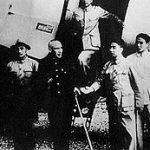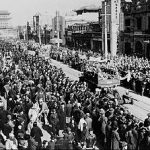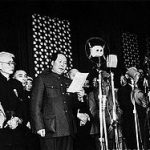History of the PRC – Part Twenty Posted by sasha on Jun 8, 2011 in Culture
With the surrender of the Japanese, a full-throttle Civil War once again raged in China. This final stage of the long, seemingly never ending war is known in Maindland China as the War of Liberation. On the side of Mao and the Communists was the Soviet Union under Stalin; on the side of Chiang and the KMT was the United States under President Truman. Knowing full well that the KMT forces outnumbered them in manpower and military equipment, the CCP followed a “passive defense” strategy, choosing to abandon territory rather than risk harming their forces.
Early on in this final stage of the war, the KMT achieved a symbolic victory by capturing the CCP capital of Yan’an (延安). There was no quit in the CCP, though, and they soon began their counter-attacks, mainly in Northern China. Beginning in September 1948 with the Liaoshen Campaign (辽沈战役 – Liáo shén zhàn yì – abbrev. for Liaoning and Shenyang) , the People’s Liberation Army made their final stance against the KMT. As Manchuria was the only place where the CCP had superior military strength, it’s no wonder this is where they chose to begin their strike. First, the PLA encircled Jinzhou (锦州), then came the Seige of Changchun (长春围困战 – Chǎng chūn wéi kùn zhàn) which lasted for 150 days and resulted in a CCP victory. Things were looking hopeless for the KMT, and they knew it. As such, they abandoned Shenyang, but they were unable to break through the PLA line of defense. Soon enough, the Communists had taken Shenyang, and thus had gained control of all of Manchuria.
Next up was the Huaihai Campaign (淮海戰役 – Huái hǎi zhàn yì), which began in early November. KMT forces were surrounded in Xuzhou (徐州). Although Chiang gathered up his best American-trained and American-armed armies, the strength of the PLA would prove to be too great. The KMT forces were wiped out, with over 550,000 casualties. As a result, Chiang’s position of power was weakened substantially. Having lost their best troops and equipment, the KMT could no longer successfully defend the Yangtze river delta. As if that weren’t enough, Truman and the US lost all confidence in the KMT, and they refused to provide any more financial or military aid. Soon enough, Chiang Kai-shek would resign.
The final stage of the war, the Pingjin Campaign (平津战役 – Píng jīn zhànyì – abbrev. for Beiping and Tianjin) soon commenced. Although the CCP would suffer great losses while securing Zhangjiakou and Tianjin, they would once again be successful. The KMT forces were driven out of Beiping, and the Communists found themselves in complete control of Northern China. Shortly thereafter, on April 21, 1949, Communist forces crossed the Yangtze river. Two days later, they took the Nationalist capital of Nanjing. While the Nationalists retreated temporarily to Guangzhou, they would soon be driven off of the Mainland.
After years of devastating battles and vicious civil war, the CCP had emerged victorious. On October 1, 1949, Mao Zedong proclaimed the founding of the People’s Republic of China (中华人民共和国 – Zhōng huá rén mín gòng hé guó). The capital, it was decided, would be Beiping. Signaling the changing times for the country, the city was renamed Beijing (北京). As for Chiang, he and about 2 million other Nationalists retreated to the island of Taiwan (台湾), keeping the name the Republic of China (中华民国 – Zhōng huá mín guó). These days, China celebrates its National Day (国庆节 – guó qìng jié) on October 1 to honor the founding of modern day China. As we have seen through twenty posts over the last few months, it took many years and countless battles to get to this point. After all of the bloodshed and hardships that China suffered in a span of less than 50 years, it is no wonder Chinese people still celebrate this crucial moment in history with great pride.
http://www.youtube.com/watch?v=Nvmf46_S7Po&feature=related
Mao Zedong proclaims the founding of the People’s Republic of China on 10/1/1949.

Build vocabulary, practice pronunciation, and more with Transparent Language Online. Available anytime, anywhere, on any device.
About the Author: sasha
Sasha is an English teacher, writer, photographer, and videographer from the great state of Michigan. Upon graduating from Michigan State University, he moved to China and spent 5+ years living, working, studying, and traveling there. He also studied Indonesian Language & Culture in Bali for a year. He and his wife run the travel blog Grateful Gypsies, and they're currently trying the digital nomad lifestyle across Latin America.







Comments:
Steven C. Poling Jr.:
沈 is shen3; not shen2.
Steven C. Poling Jr.:
Great stuff. Please be careful of switching back and forth between Simplified and Traditional.